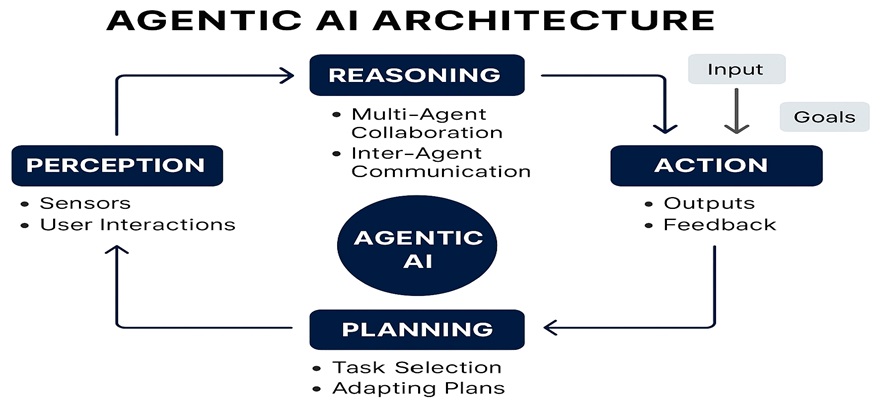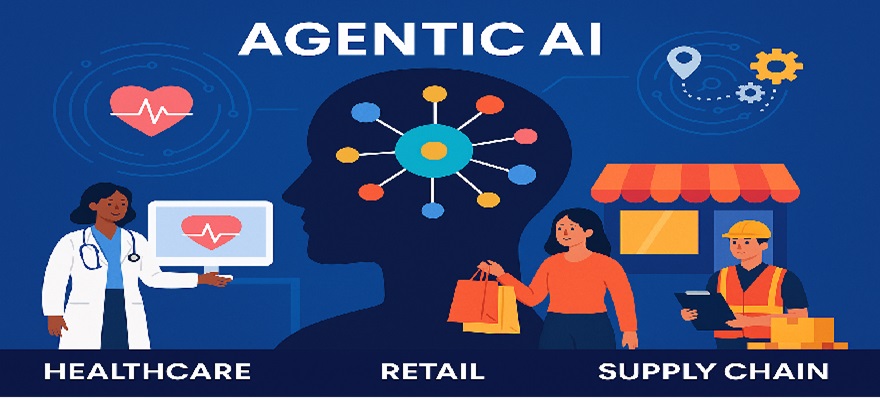- Salice Thomas
- Follow Me
- October 27, 2025
-
Introduction
Agentic AI refers to artificial intelligence systems that can plan, reason, and act independently to achieve specific goals with minimal human oversight. Unlike traditional AI, which typically responds to predefined commands or analyzes data passively, agentic AI exhibits the capacity to make decisions and take purposeful action in dynamic environments. These systems are built around AI agents often operate within multi-agent frameworks, where each agent handles a subtask and collaborates through orchestration to achieve a larger goal. In simpler terms, if generative AI is your “assistant,” agentic AI is your “colleague” who is capable of coordinating complex workflows, making data-driven decisions, and improving with experience.
Market Outlook
The market outlook for Agentic AI is highly promising, with analysts projecting rapid growth as industries seek more autonomous, goal-driven systems. Forecasts suggest the global Agentic AI market could grow from under $7 billion in 2025 to over $170 billion by 2034, driven by demand for intelligent orchestration, real-time responsiveness, and scalable autonomy. Agentic AI defined by its ability to perceive, reason, plan, and act independently, is gaining traction across sectors like retail, finance, healthcare, supply chain and so on. Its synergy with generative AI and multi-agent frameworks is accelerating adoption, enabling businesses to automate complex workflows and enhance decision-making. As organizations prioritize agility and innovation, Agentic AI is poised to become a foundational layer in enterprise transformation.
How Agentic AI Works

Agentic AI operates through autonomous agents that perceive their environment, set goals, and execute tasks with minimal human intervention. These agents are designed to reason, plan, and act, often in dynamic, unpredictable contexts. Unlike traditional AI systems that rely on static rules or reactive responses, agentic AI uses large language models and advanced algorithms to interpret data, generate strategies, and adapt in real time. The process begins with perception, where the agent gathers input from sensors, databases, or user interactions. It then engages in reasoning to evaluate options and determine the best course of action. Planning involves breaking down objectives into manageable steps, often coordinating with other agents in multi-agent systems. Finally, the agent takes action, monitors outcomes, and refines its approach based on feedback. This loop of perception, reasoning, planning, and action enables agentic AI to operate independently, solve complex problems, and continuously improve. Its ability to self-direct and collaborate makes it ideal for applications in customer service, cybersecurity, software development, and strategic decision-making. As agentic AI evolves, it promises to shift AI from a passive tool to an active partner—capable of driving innovation, managing workflows, and responding intelligently to change
Agentic AI Architecture

The Agentic AI architecture works as a continuous, intelligent feedback loop. It begins with Perception/Input, where the system receives data or user goals. This information flows into Memory, which stores both short-term and long-term knowledge. The Planning module breaks goals into actionable tasks, feeding into the Reasoning/Policy Engine, where the AI evaluates options using generative models and external tools. The Execution layer then carries out actions autonomously through integrated systems. Throughout this process, Monitoring and Analytics track performance, feeding insights back to improve memory and planning. Human-in-the-loop oversight ensures alignment with goals and ethical boundaries, while Governance & Security maintain compliance, transparency, and safe operation.
Real World Example
- Retail Campaign Autonomy
A fashion retailer uses agentic AI to manage seasonal campaigns. The system identifies top performing product categories, generates tailored ad creatives, adjusts discounts, and reallocates ad spend, all autonomously. Within weeks, conversion rates rise and human marketers focus on strategy rather than execution.
- B2B Demand Generation
A software company integrates agentic AI into its CRM. The system identifies dormant leads, re-engages them through personalized outreach, scores new prospects, and schedules follow ups for sales reps. This results in higher pipeline velocity and reduced manual workload.
Future of Agentic AI
The future of Agentic AI promises a transformative leap in how machines interact with the world, moving from passive tools to autonomous collaborators. As these systems evolve, they will increasingly demonstrate the ability to set goals, make decisions, and adapt in real time across complex environments. Businesses will deploy agentic AI to manage workflows, optimize operations, and even co-create strategies, while consumers may rely on intelligent agents to handle tasks, anticipate needs, and personalize experiences. With advances in multi-agent coordination, ethical reasoning, and contextual awareness, Agentic AI will become central to industries like healthcare, finance, education, and logistics. However, its rise also demands robust governance, transparency, and alignment with human values to ensure that autonomy enhances, not replaces human.






